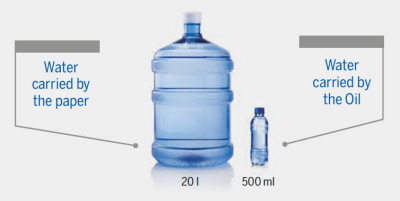How much water is there in my transformer?
Minimising water in a transformer’s insulation system is important as excess water can increase the risk of dielectric failure and can also speed up the ageing of the cellulose based paper insulation.
The cellulose based solid insulation of power transformers is hygroscopic and before drying can contain up to as much as 5% water content by weight. During transformer manufacturing a drying stage is normally always necessary where the entire active part of the transformer undergoes a vapour phase or similar drying process – to try and remove as much water as possible from the solid insulation.
Once the active part is “out of the oven” it is normally a race against time to perform some mechanical adjustments and tightening to the windings and structures – place the active part in its tank and fill it with insulating oil. This is because one wants to minimise the moisture ingress after drying processes. Mineral insulating oil also contains some water – Nynas delivers insulating oil with a dissolved water content of less than 30 ppm.
Notwithstanding, it is best engineering practice to always filter, de-gas and dry insulating oil before filling in the transformer – typically most manufacturers dry the oil to ≈5 ppm water when filling the transformer through a purification unit.
However, the question is often asked: “can wet oil severely increase the overall moisture content in my transformer?” Likewise, some often wonder if a surprisingly low insulation resistance measurement on the transformer (after filling, normally an indication of wet insulation) is not due to “wet oil”. In most cases even water-in-oil values considered to be “high” (before filling) are in fact unlikely to increase the overall water content of the transformer significantly. This is due to the simple fact that the solid insulation carries (and can hold) far more water than the oil.

Typical amounts of water
To illustrate the typical amounts of water, a simple example follows where we assume a moderately sized power transformer with the following approximate figures:
 Ideally, the solid insulation should have < 0.5% moisture by weight at time of tanking but there can be a range of acceptable/achievable levels depending on the situation. If one considers the amount of water contained in the solid insulation, just before oil filling – and in the oil itself, at time of filling (equilibrium curves do not apply):
Ideally, the solid insulation should have < 0.5% moisture by weight at time of tanking but there can be a range of acceptable/achievable levels depending on the situation. If one considers the amount of water contained in the solid insulation, just before oil filling – and in the oil itself, at time of filling (equilibrium curves do not apply):

Working on 4,000 kg of paper/cellulose
 Working on 28,000 kg of oil
Working on 28,000 kg of oil
There is indeed much lower water content in the oil than the paper in total. If one takes the example of 0.5% moisture in paper (at time of tanking, which is fairly optimistic) and 20 ppm in oil (which is fairly pessimistic as normally oil is run through a purification unit) the difference is still about 20 litres of water in the paper and 560 ml in the oil. So a rule of thumb to remember could be the water in your office’s water dispenser (in paper) versus a small drinking water bottle (in oil).
Insulating paper can hold much more water than the oil. Should one end up with unacceptably wet paper, trying to dry the paper by drying the oil is normally frivolous and therefore methods such as hot oil spraying, low frequency heating with vacuum (on the drained transformer) or repeating vapour phase drying (on the active part) are the most effective techniques in drying a wet transformer.













































